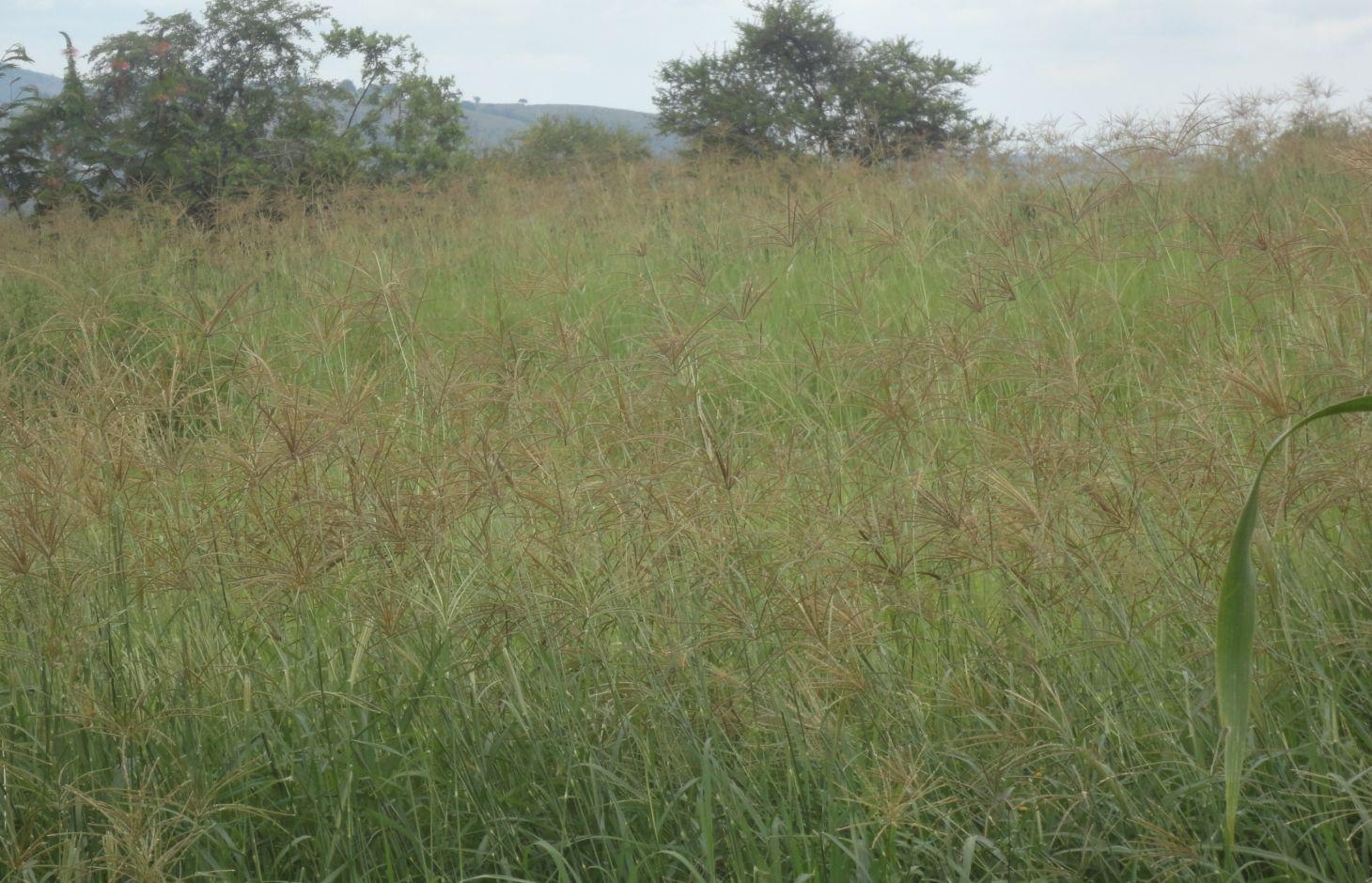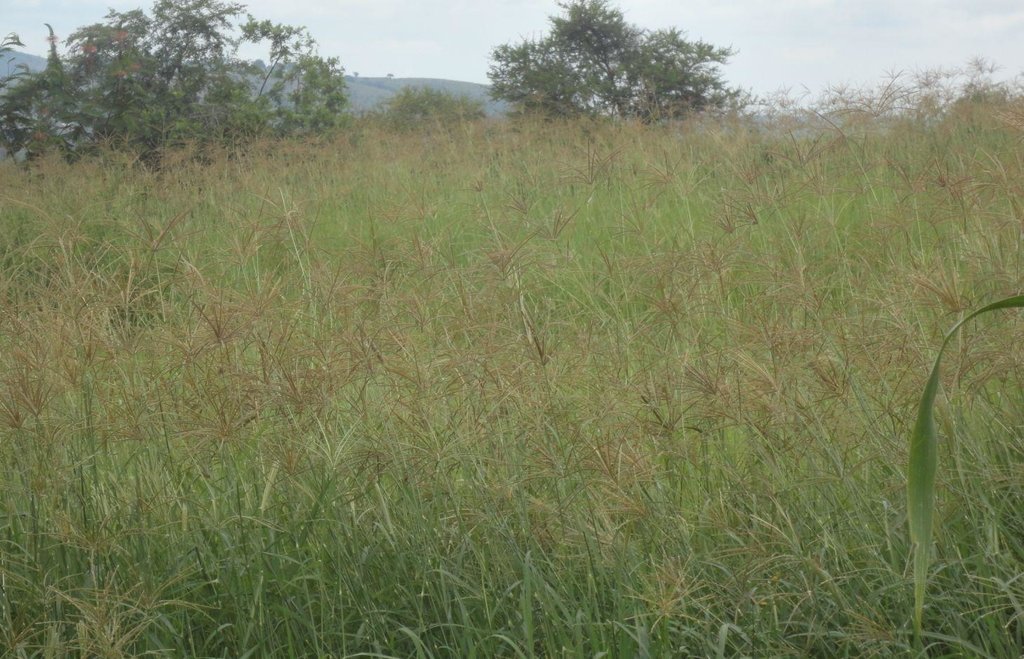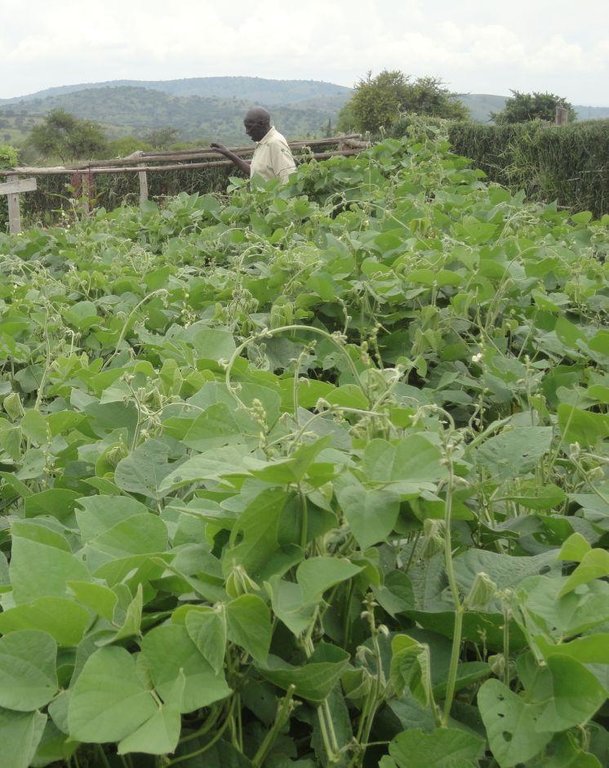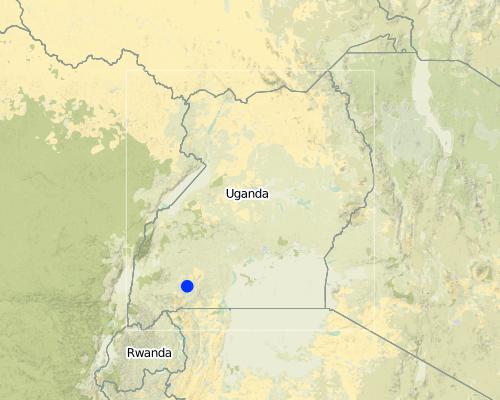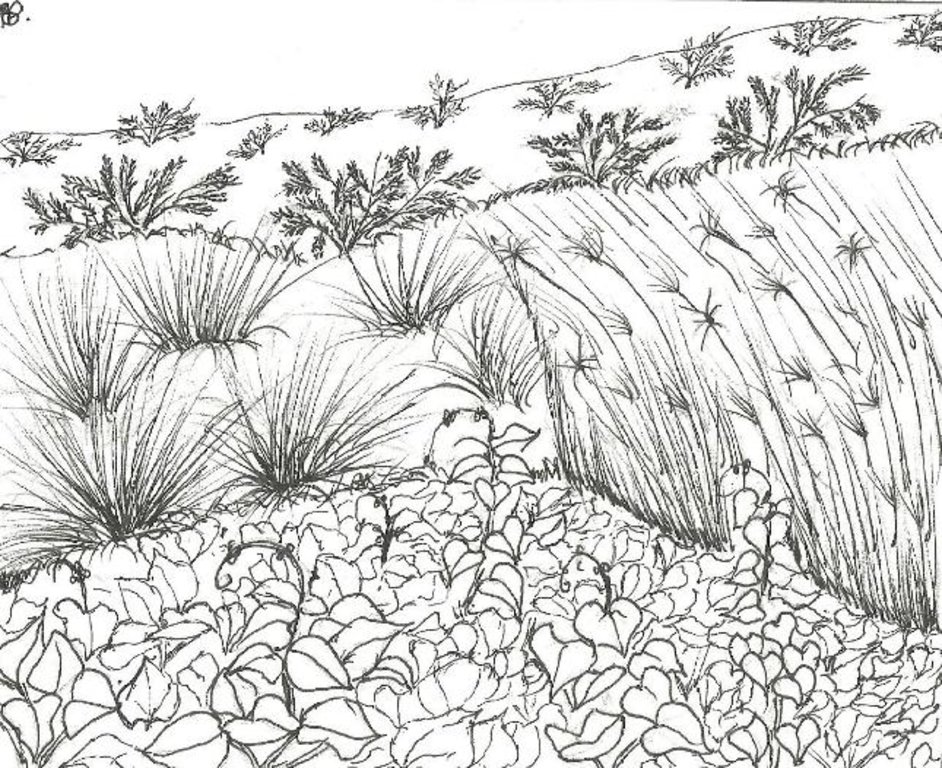Improved fodder production on degraded pastureland [Ouganda]
- Création :
- Mise à jour :
- Compilateur : Wilson Bamwerinde
- Rédacteur : –
- Examinateur : Fabian Ottiger
Okubyara Obunyatsi (Runyankore)
technologies_1588 - Ouganda
Voir les sections
Développer tout Réduire tout1. Informations générales
1.2 Coordonnées des personnes-ressources et des institutions impliquées dans l'évaluation et la documentation de la Technologie
Spécialiste GDT:
Spécialiste GDT:
Nom du projet qui a facilité la documentation/ l'évaluation de la Technologie (si pertinent)
The Transboundary Agro-ecosystem Management Project for the Kagera River Basin (GEF-FAO / Kagera TAMP )Nom du ou des institutions qui ont facilité la documentation/ l'évaluation de la Technologie (si pertinent)
Food and Agriculture Organization of the United Nations (FAO) - Italie1.3 Conditions relatives à l'utilisation par WOCAT des données documentées
Quand les données ont-elles été compilées (sur le terrain)?
09/12/2013
Le compilateur et la(les) personne(s) ressource(s) acceptent les conditions relatives à l'utilisation par WOCAT des données documentées:
Oui
2. Description de la Technologie de GDT
2.1 Courte description de la Technologie
Définition de la Technologie:
Transformation of degraded pastureland to high quality fodder plots.
2.2 Description détaillée de la Technologie
Description:
Grass and legumes are planted on degraded pasture land in fenced fodder plots within the drought prone cattle corridor of Kiruhura district. This climatic zone is characterized by short periods of intense rains followed by long dry spells. Previously, most of the pastoralists of Kiruhura led a nomadic lifestyle, moving their livestock over large areas in search of pasture and water. The combined effects of prolonged droughts and livestock movement over a defined corridor, led to increasing degradation of pastureland, reducing both the quantity and quality of pastures and worsening soil erosion. Therefore the pastoralists have settled down plant pastures instead. Grasses cultivated in the range lands of Kiruhura are Pennisetum purpureum (elephant grass), Stylosanthes guianensis (stylo), Chloris gayana. The legumes are Calliandra spp. and lablab.
Purpose of the Technology: The main objective of the technology is to improve the availability of quality forage and fodder for livestock during the dry season and to feed small ruminants. The other objective is to stop runoff which usually destroys crops, increase water infiltration during the rains and lessen the effect of floods. The benefits of fodder cropping include the protection of soil from erosion by increasing surface cover, improved soil fertility from the legumes, improved livestock production and consequently higher manure production.
Establishment / maintenance activities and inputs: Establishment involves digging, to loosen the soil and remove other grasses that would compete with the planted grasses. Digging is labor intensive and the land owner usually hires labor. The technology requires simple gardening tools such as the hand hoe for digging the soil, and a panga to clear invasive bushes, usually Lantana camara. In addition, irrigation may be necessary in the first 2 to 3 months even during the rainy season. Elephant grass is propagated vegetatively using cuttings planted in rows. Chloris gayana is propagated by broadcasting the seed. Lablab seeds are germinated by soaking in water and then planted directly in the prepared plot. Calliandra is first planted in nurseries before transplanting the seedlings.
Because of the erratic rains, irrigating the plots in the first few months of cultivation is critical.
Natural / human environment: The plots fenced off to protect the fodder crops.
2.3 Photos de la Technologie
2.5 Pays/ région/ lieux où la Technologie a été appliquée et qui sont couverts par cette évaluation
Pays:
Ouganda
Région/ Etat/ Province:
Uganda
Autres spécifications du lieu:
Kiruhura District (Sanga)
Commentaires:
Boundary points of the Technology area: -0.50810 30.91070; -0.50763 30.91055; -0.50788 30.91006; -0.50838 30.91017; -0.50843 30.91073
Map
×2.6 Date de mise en œuvre de la Technologie
Si l'année précise est inconnue, indiquez la date approximative: :
- il y a moins de 10 ans (récemment)
2.7 Introduction de la Technologie
Spécifiez comment la Technologie a été introduite: :
- par le biais de projets/ d'interventions extérieures
Commentaires (type de projet, etc.) :
Fodder cropping was introduced 2 years ago by Kagera TAMP project
3. Classification de la Technologie de GDT
3.1 Principal(aux) objectif(s) de la Technologie
- améliorer la production
- réduire, prévenir, restaurer les terres dégradées
3.2 Type(s) actuel(s) d'utilisation des terres, là où la Technologie est appliquée

Pâturages
Pâturage intensif/ production fourragère :
- Affouragement en vert/ zéro-pâturage
- Prairies améliorées

Mixte (cultures/ pâturages/ arbres), incluant l'agroforesterie
- Agro-pastoralisme
Commentaires:
Major land use problems (compiler’s opinion): Degradation of pasture range-lands through overgrazing; Animal movement exposes top soil to erosion.
Major land use problems (land users’ perception): Decrease of pasture and water during the dry season; labor to get water and good pasture is a big challenge during prolonged drought.
Cut-and-carry/ zero grazing: Yes
Improved pasture: Yes
Mixed: (eg agro-pastoralism, silvo-pastoralism): Yes
Future (final) land use (after implementation of SLM Technology): Grazing land: Gi: Intensive grazing/ fodder production
Si l'utilisation des terres a changé en raison de la mise en œuvre de la Technologie, indiquez l'utilisation des terres avant la mise en œuvre de la Technologie:
Grazing land: Ge: Extensive grazing land
3.3 Informations complémentaires sur l'utilisation des terres
Approvisionnement en eau des terres sur lesquelles est appliquée la Technologie:
- pluvial
Précisez:
Longest growing period in days: 90 Longest growing period from month to month: March to May Second longest growing period in days: 90 Second longest growing period from month to month: October to December
Densité d'élevage/ chargement (si pertinent):
25-50 LU /km2
3.4 Groupe de GDT auquel appartient la Technologie
- fermeture de zones (arrêt de tout usage, appui à la réhabilitation)
- Amélioration de la couverture végétale/ du sol
3.5 Diffusion de la Technologie
Commentaires:
Total area covered by the SLM Technology is 0.05 m2.
Acreage under fodder crops is increasing every season as farmers plant more grass and legumes.
3.6 Mesures de GDT constituant la Technologie

pratiques végétales
- V2: Herbes et plantes herbacées pérennes

modes de gestion
- M2: Changement du niveau de gestion / d'intensification
Commentaires:
Main measures: vegetative measures, management measures
Type of vegetative measures: in blocks
3.7 Principaux types de dégradation des terres traités par la Technologie

érosion hydrique des sols
- Wt: perte de la couche superficielle des sols (couche arable)/ érosion de surface

dégradation biologique
- Bc: réduction de la couverture végétale
- Bq: baisse de la quantité/ biomasse
Commentaires:
Main type of degradation addressed: Wt: loss of topsoil / surface erosion, Bc: reduction of vegetation cover
Secondary types of degradation addressed: Bq: quantity / biomass decline
Main causes of degradation: deforestation / removal of natural vegetation (incl. forest fires) (Pasture regeneration practice of bush burning), overgrazing (Maintaining large herds as a repository of wealth), change of seasonal rainfall (Climate change), droughts (Climate change)
Secondary causes of degradation: population pressure (The cattle corridor had a very sparse, mostly nomadic population. Herders have settled down and human population density has grown quite fast in the range-lands)
3.8 Prévention, réduction de la dégradation ou réhabilitation des terres dégradées
Spécifiez l'objectif de la Technologie au regard de la dégradation des terres:
- réduire la dégradation des terres
4. Spécifications techniques, activités, intrants et coûts de mise en œuvre
4.1 Dessin technique de la Technologie
4.2 Spécification/ explications techniques du dessin technique
Transformation of degraded pastureland to high quality fodder plots based on establishment of vegetation cover: Pennisetum purpureum (elephant grass), Stylosanthes guianensis (stylo), Chloris gayana, Calliandra and Lablab
Location: Sanga sub-county, Kiruhura district. Uganda
Date: 6-DEC-2013
Technical knowledge required for field staff / advisors: moderate (Methods of land and seed preparation for the various fodder crops)
Technical knowledge required for land users: moderate (Maintenance of the fodder plots)
Main technical functions: control of dispersed runoff: impede / retard, improvement of ground cover, increase in nutrient availability (supply, recycling,…), promotion of vegetation species and varieties (quality, eg palatable fodder)
Secondary technical functions: control of raindrop splash, increase of infiltration, increase / maintain water stored in soil, increase of biomass (quantity)
In blocks
Vegetative material: T : trees / shrubs, G : grass
Trees/ shrubs species: Calliandra Spp. and Grevillea grown in nursery beds before planting; lablab planted directly
Fruit trees / shrubs species: n/a
Perennial crops species: n/a
Grass species: seeds broadcast on land prepared by digging with a hand hoe
Other species: n/a
Slope (which determines the spacing indicated above): 10 - 15%
Change of land use practices / intensity level: From extensive grazing to intensive (semi-zero) grazing
Control / change of species composition: From purely natural pastures to planted fodder crops
4.3 Informations générales sur le calcul des intrants et des coûts
autre/ monnaie nationale (précisez):
UGX
Indiquer le taux de change du dollars en monnaie locale (si pertinent): 1 USD= :
2500,0
Indiquez le coût salarial moyen de la main d'œuvre par jour:
4.00
4.4 Activités de mise en place/ d'établissement
| Activité | Type de mesures | Calendrier | |
|---|---|---|---|
| 1. | Preparation of fodder plots (bush clearing, digging, fencing) | Végétale | dry season |
| 2. | Nursery establishment for Calliandra | Végétale | dry season |
| 3. | Planting | Végétale | Beginning of wet season |
| 4. | Weeding | Végétale | Wet season |
| 5. | Paddocking | Modes de gestion | dry season |
4.5 Coûts et intrants nécessaires à la mise en place
| Spécifiez les intrants | Unité | Quantité | Coûts par unité | Coût total par intrant | % des coût supporté par les exploitants des terres | |
|---|---|---|---|---|---|---|
| Main d'œuvre | Labour | ha | 1,0 | 110,0 | 110,0 | 100,0 |
| Equipements | Tools | ha | 1,0 | 8,0 | 8,0 | 100,0 |
| Matériel végétal | Seeds | ha | 1,0 | 25,0 | 25,0 | |
| Engrais et biocides | Compost/manure | ha | 1,0 | 30,0 | 30,0 | 100,0 |
| Matériaux de construction | Wood | ha | 1,0 | 200,0 | 200,0 | 50,0 |
| Matériaux de construction | Fencing wire (roll) | ha | 1,0 | 40,0 | 40,0 | 100,0 |
| Coût total de mise en place de la Technologie | 413,0 | |||||
Commentaires:
Duration of establishment phase: 18 month(s)
4.6 Activités d'entretien/ récurrentes
| Activité | Type de mesures | Calendrier/ fréquence | |
|---|---|---|---|
| 1. | Weeding and fodder preparation | Végétale | wet season |
| 2. | Gap-filling/replanting | Végétale | Wet season |
| 3. | Maintenance of paddocks | Modes de gestion | 2 times a year |
4.7 Coûts et intrants nécessaires aux activités d'entretien/ récurrentes (par an)
| Spécifiez les intrants | Unité | Quantité | Coûts par unité | Coût total par intrant | % des coût supporté par les exploitants des terres | |
|---|---|---|---|---|---|---|
| Main d'œuvre | Labour | ha | 1,0 | 60,0 | 60,0 | 100,0 |
| Equipements | Tools | ha | 1,0 | 8,0 | 8,0 | 100,0 |
| Matériel végétal | Seeds | ha | 1,0 | 25,0 | 25,0 | 100,0 |
| Engrais et biocides | Compost/manure | ha | 1,0 | 30,0 | 30,0 | 100,0 |
| Matériaux de construction | Wood | ha | 1,0 | 100,0 | 100,0 | 100,0 |
| Matériaux de construction | Fencin wire | ha | 1,0 | 40,0 | 40,0 | 100,0 |
| Coût total d'entretien de la Technologie | 263,0 | |||||
Commentaires:
Machinery/ tools: hand hoe, panga, rake, n/a
The calculations above were done in December 2013, for gently sloping land (< 6%), for each of 5 hectares covered by the technology.
4.8 Facteurs les plus importants affectant les coûts
Décrivez les facteurs les plus importants affectant les coûts :
Fencing the land is the most important factor in establishing the technology. The whole cattle corridor is an extended range land with a lot of livestock. Fodder plots constantly face destruction by freely roaming livestock and therefore fencing is a requirement. Paddocking also requires fencing to divide the farm into portions of pasture. Both materials and labor are costly.
5. Environnement naturel et humain
5.1 Climat
Précipitations annuelles
- < 250 mm
- 251-500 mm
- 501-750 mm
- 751-1000 mm
- 1001-1500 mm
- 1501-2000 mm
- 2001-3000 mm
- 3001-4000 mm
- > 4000 mm
Spécifications/ commentaires sur les précipitations:
850 mm to 900 mm
Zone agro-climatique
- subhumide
Thermal climate class: Tropics. At the Equator with 180 days of growing period
5.2 Topographie
Pentes moyennes:
- plat (0-2 %)
- faible (3-5%)
- modéré (6-10%)
- onduleux (11-15%)
- vallonné (16-30%)
- raide (31-60%)
- très raide (>60%)
Reliefs:
- plateaux/ plaines
- crêtes
- flancs/ pentes de montagne
- flancs/ pentes de colline
- piémonts/ glacis (bas de pente)
- fonds de vallée/bas-fonds
Zones altitudinales:
- 0-100 m
- 101-500 m
- 501-1000 m
- 1001-1500 m
- 1501-2000 m
- 2001-2500 m
- 2501-3000 m
- 3001-4000 m
- > 4000 m
Commentaires et précisions supplémentaires sur la topographie:
Altitudinal zone: 1001-1500 m a.s.l. (1330 m to 1345 m a.s.l.)
Slopes on average: Gentle (Extensive area of grazing land cover both gentle and moderate slopes) and moderate (both ranked 2)
5.3 Sols
Profondeur moyenne du sol:
- très superficiel (0-20 cm)
- superficiel (21-50 cm)
- modérément profond (51-80 cm)
- profond (81-120 cm)
- très profond (>120 cm)
Texture du sol (de la couche arable):
- moyen (limoneux)
Matière organique de la couche arable:
- faible (<1%)
Si disponible, joignez une description complète du sol ou précisez les informations disponibles, par ex., type de sol, pH/ acidité du sol, capacité d'échange cationique, azote, salinité, etc.
Soil fertility: Medium
Soil drainage/infiltration: Medium
Soil water storage capacity: Medium
5.4 Disponibilité et qualité de l'eau
Profondeur estimée de l’eau dans le sol:
5-50 m
Disponibilité de l’eau de surface:
moyenne
Qualité de l’eau (non traitée):
faiblement potable (traitement nécessaire)
5.5 Biodiversité
Diversité des espèces:
- faible
5.6 Caractéristiques des exploitants des terres appliquant la Technologie
Orientation du système de production:
- subsistance (auto-approvisionnement)
Revenus hors exploitation:
- moins de 10% de tous les revenus
Niveau relatif de richesse:
- moyen
- riche
Individus ou groupes:
- individu/ ménage
Genre:
- hommes
Indiquez toute autre caractéristique pertinente des exploitants des terres:
Land users applying the Technology are mainly common / average land users
Difference in the involvement of women and men: Herds and the land they graze on traditionally belongs to men. This seems to have remained the case, where women's roles are within the house and around the compound while men tend the live stock. Nonetheless, women are getting hired as labourers in the nurseries and for digging.
Population density: 10-50 persons/km2
Annual population growth: 2% - 3%
15% of the land users are rich and own 30% of the land (can afford to spend 150.00 US$ per month on farm expenses).
60% of the land users are average wealthy and own 40% of the land (can spend 500.00 annually on the farm).
Off-farm income specification: Most of the economy in Kiruhura district is farm-based. Almost everybody earns directly from their farm produce or labour.
Market orientation: Mixed (ranked 1, herders have surplus milk for sale) and subsistence (ranked 2, herders grow their own food)
5.7 Superficie moyenne des terres détenues ou louées par les exploitants appliquant la Technologie
- < 0,5 ha
- 0,5-1 ha
- 1-2 ha
- 2-5 ha
- 5-15 ha
- 15-50 ha
- 50-100 ha
- 100-500 ha
- 500-1 000 ha
- 1 000-10 000 ha
- > 10 000 ha
Cette superficie est-elle considérée comme de petite, moyenne ou grande dimension (en se référant au contexte local)?
- moyenne dimension
5.8 Propriété foncière, droits d’utilisation des terres et de l'eau
Propriété foncière:
- individu, sans titre de propriété
Droits d’utilisation des terres:
- individuel
Droits d’utilisation de l’eau:
- accès libre (non organisé)
Commentaires:
Once herders started settling down land came under individual ownership. This development is only a few decades old. Water is still under open access.
5.9 Accès aux services et aux infrastructures
santé:
- pauvre
- modéré
- bonne
éducation:
- pauvre
- modéré
- bonne
assistance technique:
- pauvre
- modéré
- bonne
emploi (par ex. hors exploitation):
- pauvre
- modéré
- bonne
marchés:
- pauvre
- modéré
- bonne
énergie:
- pauvre
- modéré
- bonne
routes et transports:
- pauvre
- modéré
- bonne
eau potable et assainissement:
- pauvre
- modéré
- bonne
services financiers:
- pauvre
- modéré
- bonne
6. Impacts et conclusions
6.1 Impacts sur site que la Technologie a montrés
Impacts socio-économiques
Production
production fourragère
Quantité avant la GDT:
0 acre
Quantité après la GDT:
6 acre
qualité des fourrages
production animale
risque d'échec de la production
Revenus et coûts
dépenses pour les intrants agricoles
revenus agricoles
charge de travail
Impacts socioculturels
institutions communautaires
connaissances sur la GDT/ dégradation des terres
apaisement des conflits
Improved livelihoods and human well-being
Commentaires/ spécifiez:
Implementation of the fodder cropping technology helps to maintain small and productive herds in a short distance from the households. As a result, milk production improved significantly, thereby improving household incomes.
Impacts écologiques
Cycle de l'eau/ ruissellement
ruissellement de surface
évaporation
Sols
couverture du sol
perte en sol
encroûtement/ battance du sol
compaction du sol
cycle/ recharge des éléments nutritifs
Biodiversité: végétale, animale
biomasse/ au dessus du sol C
Réduction des risques de catastrophe et des risques climatiques
risques d'incendies
6.2 Impacts hors site que la Technologie a montrés
dommages sur les champs voisins
dommages sur les infrastructures publiques/ privées
6.3 Exposition et sensibilité de la Technologie aux changements progressifs et aux évènements extrêmes/catastrophes liés au climat (telles que perçues par les exploitants des terres)
Changements climatiques progressifs
Changements climatiques progressifs
| Saison | Type de changements/ extrêmes climatiques | Comment la Technologie fait-elle face à cela? | |
|---|---|---|---|
| températures annuelles | augmente | pas connu |
Extrêmes climatiques (catastrophes)
Catastrophes météorologiques
| Comment la Technologie fait-elle face à cela? | |
|---|---|
| pluie torrentielle locale | bien |
| tempête de vent locale | bien |
Catastrophes climatiques
| Comment la Technologie fait-elle face à cela? | |
|---|---|
| sécheresse | bien |
Catastrophes hydrologiques
| Comment la Technologie fait-elle face à cela? | |
|---|---|
| inondation générale (rivière) | pas connu |
Autres conséquences liées au climat
Autres conséquences liées au climat
| Comment la Technologie fait-elle face à cela? | |
|---|---|
| réduction de la période de croissance | bien |
Commentaires:
In preparation for extended drought, hay is made during the rainy season when there is abundant grass.
6.4 Analyse coûts-bénéfices
Quels sont les bénéfices comparativement aux coûts de mise en place (du point de vue des exploitants des terres)?
Rentabilité à court terme:
légèrement négative
Rentabilité à long terme:
très positive
Quels sont les bénéfices comparativement aux coûts d'entretien récurrents (du point de vue des exploitants des terres)?
Rentabilité à court terme:
positive
Rentabilité à long terme:
très positive
Commentaires:
Establishment costs are rather high. In the medium to longer term, the benefits are immense. Maintenance costs are reduced once the technology is established because expenditure on animal drugs goes down with decreasing parasite infestations (especially ticks) which were a result of mixing with untreated herds before.
6.5 Adoption de la Technologie
Si disponible, quantifiez (nombre de ménages et/ou superficie couverte):
20
Parmi tous ceux qui ont adopté la Technologie, combien d'entre eux l'ont fait spontanément, à savoir sans recevoir aucune incitation matérielle ou aucun paiement?
- 10-50%
Commentaires:
75% of land user families have adopted the Technology with external material support
15 land user families have adopted the Technology with external material support
Comments on acceptance with external material support: Supply of grass and legume seeds was done for the original 15 families; 5 more families are working on the technology after seeing its results from their neighbours.
25% of land user families have adopted the Technology without any external material support
5 land user families have adopted the Technology without any external material support
Comments on spontaneous adoption: 5 farmers have adopted the technology without getting any external help
There is a moderate trend towards spontaneous adoption of the Technology
Comments on adoption trend: 25% of the farmers who adopted the technology did so without external support.
6.7 Points forts/ avantages/ possibilités de la Technologie
| Points forts/ avantages/ possibilités du point de vue de l'exploitant des terres |
|---|
|
Improved income from milk with reduced expenses on acaricides and other drugs means that household income is higher How can they be sustained / enhanced? Encourage improvement of the herd by reducing the numbers and enhancing the quality through breeding and acqusition |
|
Less time is spent on searching for pastures further afield. How can they be sustained / enhanced? Encourage the herder to put more acreage under planted pastures |
| Points forts/ avantages/ possibilités du point de vue du compilateur ou d'une autre personne ressource clé |
|---|
|
There is enough grass and fodder for the herd during the rainy season and hay during the extended droughts. How can they be sustained / enhanced? More mobilization campaigns, grass and legume seeds and other incentives should be availed to the herders to enhance rate and extent of adoption. |
|
Intensive grazing favours smaller, high productivity herds How can they be sustained / enhanced? Policy to improve herd quality should be pursued at government level |
|
Planted pasture enhances responsibility to protect and maintain grazing land by the owner, thereby improving capacity to sustain soil management benefits (increased surface cover, reduced water erosion) How can they be sustained / enhanced? Community level by-laws should be enacted to compel every herder to have some planted pastures for fodder. |
|
Improved milk and other farm product yields How can they be sustained / enhanced? Introduce marketing strategies including cooperatives to ensure that the benefits go to the farmers and not marketing middle-men. |
6.8 Faiblesses/ inconvénients/ risques de la Technologie et moyens de les surmonter
| Faiblesses/ inconvénients/ risques du point de vue de l’exploitant des terres | Comment peuvent-ils être surmontés? |
|---|---|
| There is shortage of labor to increase acreage, cut the grass and legumes from the pasture plots and prepare fodder for semi zero-grazing | Use simple machines where possible |
| Faiblesses/ inconvénients/ risques du point de vue du compilateur ou d'une autre personne ressource clé | Comment peuvent-ils être surmontés? |
|---|---|
| Establishment costs are rather high | Benefits demonstrated by the herders who adopted the technology should convince government and commercial banks that the technology is profitable. Upon this evidence alone, these institutions should avail the herders the necessary capital. |
| Technology is labour intensive | Productivity is even higher, therefore innovations that introduce mechanization should be encouraged (it is the normal progression of agricultural/industrial development) |
7. Références et liens
7.2 Références des publications disponibles
Titre, auteur, année, ISBN:
Kagera TAMP project website
Disponible à partir d'où? Coût?
http://www.fao.org/nr/kagera/en/
Liens et modules
Développer tout Réduire toutLiens
Aucun lien
Modules
Aucun module trouvé


